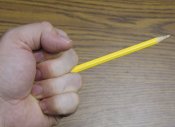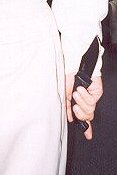I read recently a polemic written by a traditionalist judoka very concerned about issues of “credibility” in the martial arts. He rightly drew a distinction between martial sports, practiced for “personal development,” and more modern, more pragmatic, or nontraditional arts whose focus remains the delivery of force. Believing that the least common goal among martial arts practitioners today was “to kill or maim an opponent,” the judoka opined that the majority of instructors teaching combative arts lacked “real-life experience.”
Grudgingly excepting those who might have military or law-enforcement experience, the judoka complained that the innocent, naïve students of such instructors, foolishly assuming their teachers are imparting valid and tested knowledge, are in fact being taught by those who preach conjecture and theory only. Through what agency this knowledge of the lives of others was given the judoka we cannot know, but he assumed in his essay that such individuals — and those who taught them — were unlikely ever to have faced another individual in “actual mortal combat.”
Going on to admit, again perhaps grudgingly, that many people seek out instructions in the martial arts from fear — in order to defend themselves from assault — the erstwhile warrior lamented that in no other field of human endeavor would reasonable people trust teachers who were themselves “inexperienced novices.” He pointed out, rightly, that teachers of martial sports don’t have to worry about a lack of authority stemming from their lack of experience actually fighting hostile adversaries, for their experience is the realm of sport makes them authorities on those sports. No one, after all, would expect a judoka or karateka of many years tournament experience to speak with credibility on the subject of fighting street hoodlums.
Would they?
What our well-meaning but uninformed judoka missed, in the course of his essay, was the fact that too few people today, be they outsiders looking in or “martial” artists practicing a traditional or nontraditional art or system, understand the purpose of the martial arts. These same people ignorantly participate in arts — be they traditional or otherwise — that leave them with something far worse than the inability to defend themselves: the delusion that they can use such a style for self-defense. The line between sport and martial arts has become so blurred by this ignorance that even traditionalists who understand the difference fail to grasp its implications.
The very people our judoka worries will dash themselves on legal or physical rocks after being taken in by the siren song of black-clad novice combatives poseurs are the ones who, fearing for their physical well-being, turn to commercial strip-mall dojos and sports schools to learn what they mistakenly believe is applicable to real-world self-defense.
 It is true that there are, among the “combat” and “reality fighting” systems, schools, and teachers in the field today, numerous individuals preaching conduct of dubious merit and techniques of questionable veracity. If the student finds the former but is pleased by an absence of the latter, he or she must simply engage his or her mind to glean physical benefit from the teaching while disregarding advocated behavior he or she knows — thanks to common sense and critical thinking — to be foolish. If the student is confronted by the latter, regardless of what is advocated behaviorally by the teacher, he or she should be learning elsewhere anyway.
It is true that there are, among the “combat” and “reality fighting” systems, schools, and teachers in the field today, numerous individuals preaching conduct of dubious merit and techniques of questionable veracity. If the student finds the former but is pleased by an absence of the latter, he or she must simply engage his or her mind to glean physical benefit from the teaching while disregarding advocated behavior he or she knows — thanks to common sense and critical thinking — to be foolish. If the student is confronted by the latter, regardless of what is advocated behaviorally by the teacher, he or she should be learning elsewhere anyway.
What traditionalists or sports practitioners looking down their noses at “combat” stylists don’t seem to want to see, however, is that these problems exist in all styles in the martial arts, self-defense, and “martial” sports fields. Entire Internet forums have been devoted to outing such frauds — people who fake their lineages, who claim falsely to have trained with luminaries in their chosen disciplines, who teach faulty techniques, who abuse or mistreat their students physically or emotionally, who engage in unsound financial practices, who start what amount to cults of personality. The martial arts, traditional or nontraditional, attract a great many poseurs with varying specialties and interests and fetishes.
At no time does the student have the luxury to allow a teacher or another student to think for him or for her. You must apply critical thinking to everything you do.
The proof, as always, is in the substance of what is taught.
Does it stand up to critical, logical analysis or doesn’t it?
Our judoka apparently disregarded the fact that the majority of highly regarded combatives exponents today, while perhaps (though we do not know unless they choose to share personal information with us) having never murdered or necessarily maimed another person, are themselves the products of brutal or noteworthy lives spent fighting and preserving their lives in hostile real-life environments. Some are bouncers, some are admitted former street hooligans, some have spent time in prison, and some have had their outlooks altered by traumatic events. As in more traditional or sporting venues, however, the exponents of combative systems whose techniques lack veracity or whose backgrounds are more fiction than fact often find themselves jokes within their chosen fields — the punch lines to endless Internet debates.
Unlike our judoka, I don’t think the majority of students in martial or sporting fields today are stupid, incapable of deciding for themselves when a teacher is not a good one. There are people who are duped and there are people who suffer as a result of being duped, but this is true for every venue in life. You might counter, reading this, that combative systems whose teachers impart information harmful to students cause damage much greater than the damage caused by fraudulent weight loss systems or dating guides, and you’d be right. The fact is, though, that you as an individual remain responsible for your actions — and the task to think critically about what you do and what you believe remains yours.
There is another aspect to this that our judoka did not consider, which is that the majority of well-known combatives and reality fighting teachers today are not ignorant of the consequences of violence, not unaware of the appropriate use of force in both physical and legal contexts. Some have spent considerable time and print space dealing with these issues thoughtfully and thoroughly.
What, then, of the credibility issue? Even if sports practitioners do not claim to be anything but sports practitioners and their students understand this, to whom does the student seeking to learn realistic self-defense turn when, according to our judoka, the majority of teachers of combat systems are theorizing novices?
Fortunately for those students, the judoka is wrong. There are many teachers of such systems who do indeed have the experiences — real fights with real people who meant them real harm — that grants the kind of credibility our traditionalist seems to think is important. Even if they did not, however, consider the concept of ad hominem again.
 Does a chin jab or a dropstep blow become any less effective – when finally used against a human being – when practiced only on the grimacing rubber head of a Body Opponent Bag? Does a finger flick to the eyes become any less effective, when finally used “for real,” if it has never before been used to poke out a real eyeball? Those who question the credibility of combat teachers would seem to want it both ways: they wish to be able to judge, as sports practitioners whose arts do not teach realistic self-defense, the “credibility” of those whose systems can be seen to do just that when examined logically and critically. A few, perhaps law enforcement officers or veterans of decades-old wars, are scornful of those who do not share their experiences — while failing, in dismissing the “credibility” of those people, to address the substance of the systems those “novices” advocate.
Does a chin jab or a dropstep blow become any less effective – when finally used against a human being – when practiced only on the grimacing rubber head of a Body Opponent Bag? Does a finger flick to the eyes become any less effective, when finally used “for real,” if it has never before been used to poke out a real eyeball? Those who question the credibility of combat teachers would seem to want it both ways: they wish to be able to judge, as sports practitioners whose arts do not teach realistic self-defense, the “credibility” of those whose systems can be seen to do just that when examined logically and critically. A few, perhaps law enforcement officers or veterans of decades-old wars, are scornful of those who do not share their experiences — while failing, in dismissing the “credibility” of those people, to address the substance of the systems those “novices” advocate.
The reader could again counter that a student who has not used these skills against another human being has no idea what he or she will do when called on to employ them for real. The same, however, is true for every student of sporting arts who leaves the dojo believing an upper-block, back step, reverse punch combination will defeat a knife-wielding attacker. The same is true for every student of every system, traditional or not, “combative” or not, no matter how many notches his or her instructor has carved in his belt or into the flesh of his arm.
As for the “legal” advice offered or the morality invoked by such teachers… Who is responsible for what you believe regarding the appropriate use of force and the legal consequences you will suffer? Who makes the choice of action? Who decides in which art you train? It is the same person who is responsible, ultimately, for the tenor and the progress of your training: you. No one can do your thinking or your homework for you. How much risk are you willing to suffer, physical and legal, before and after the fact? Who is responsible for assuming the risk of a violent encounter — you or the attacker?
An aged judoka speculating that your combatives instructor was a bedwetter as a child, or telling you that you will be flayed alive by the authorities if a copy of Tactical Knives is found under your pillow, could be right on both counts. As in anything, you’ll have to weigh his opinion and his credibility for what they are in deciding how to conduct your life and how to educate yourself.
The choice is yours. It always was.